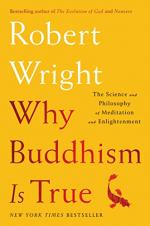
|
| Name: _________________________ | Period: ___________________ |
This test consists of 5 short answer questions, 10 short essay questions, and 1 (of 3) essay topics.
Short Answer Questions
1. The author states that rather than seeing the world as hopeless and empty, enlightened and otherwise accomplished meditators see each individual object, person, and experience as empty in the sense that it does not have a preset what?
2. What sound does the author refer to in his personal anecdote about reducing negative feelings?
3. What type of bird was rated the most highly in the study introduced by the author under the heading "Infiltration of Perception by Feeling" (159)?
4. The author states that what element only acts as a proxy between various feelings?
5. Chapter 10 is entitled "Encounters With the" what?
Short Essay Questions
1. What does the author mean when he claims that humans are essentialists?
2. What emotion is one of the most studied in relation to the phenomenon of modules governing behavior and why?
3. What three careers are used to characterize the three different schools of meditation and on which type does the author focus within Buddhism is True?
4. For what purpose does the author discuss his disagreement with a prominent meditation teacher?
5. What is the significance of the author's discussion of the Capgras delusion?
6. How does the author characterize the emotion of jealousy?
7. What is one method the author suggests for a way to observe one's thoughts objectively?
8. How does the author use the example of weeds and flowers to make a point about emptiness?
9. Describe Plato's use of the horse and charioteer analogy to comment on the relationship between feelings and the rational self.
10. Discuss the author's perspective of how indulging one's craving once can lead to future indulgences?
Essay Topics
Write an essay for ONE of the following topics:
Essay Topic 1
Choose a symbolic object from Robert Wright's book Buddhism is True, such as the chocolate bar, the lizard, or some other symbolic object and discuss its overall meaning and its connection to themes within the text.
Essay Topic 2
What messages does Robert Wright's book Buddhism is True send to the audience about the themes of isolation and outreach?
Essay Topic 3
How is the theme of desire portrayed in Robert Wright's book Buddhism is True? Examine the author's treatment of and messages regarding desire throughout the book.
|
This section contains 1,235 words (approx. 5 pages at 300 words per page) |

|




